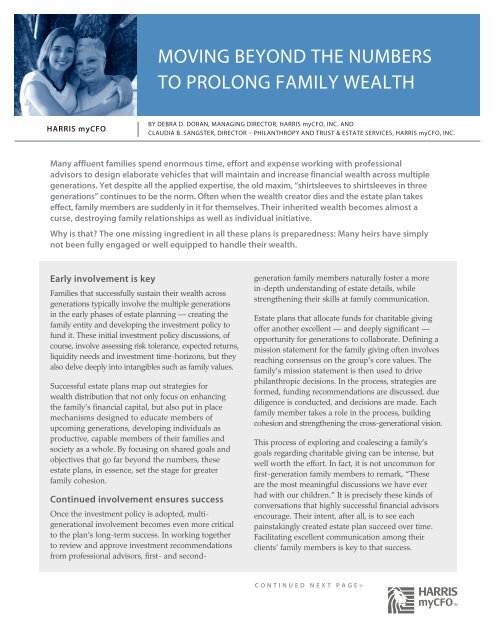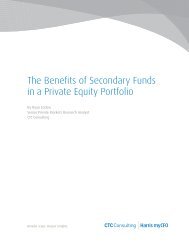moving beyond the numbers to prolong family wealth - myCFO
moving beyond the numbers to prolong family wealth - myCFO
moving beyond the numbers to prolong family wealth - myCFO
You also want an ePaper? Increase the reach of your titles
YUMPU automatically turns print PDFs into web optimized ePapers that Google loves.
MOVING BEYOND THE NUMBERS<br />
TO PROLONG FAMILY WEALTH<br />
HARRIS <strong>myCFO</strong><br />
BY DEBRA D. DORAN, MANAGING DIRECTOR, HARRIS <strong>myCFO</strong>, INC. AND<br />
CLAUDIA B. SANGSTER, DIRECTOR – PHILANTHROPY AND TRUST & ESTATE SERVICES, HARRIS <strong>myCFO</strong>, INC.<br />
Many affluent families spend enormous time, effort and expense working with professional<br />
advisors <strong>to</strong> design elaborate vehicles that will maintain and increase financial <strong>wealth</strong> across multiple<br />
generations. Yet despite all <strong>the</strong> applied expertise, <strong>the</strong> old maxim, “shirtsleeves <strong>to</strong> shirtsleeves in three<br />
generations” continues <strong>to</strong> be <strong>the</strong> norm. Often when <strong>the</strong> <strong>wealth</strong> crea<strong>to</strong>r dies and <strong>the</strong> estate plan takes<br />
effect, <strong>family</strong> members are suddenly in it for <strong>the</strong>mselves. Their inherited <strong>wealth</strong> becomes almost a<br />
curse, destroying <strong>family</strong> relationships as well as individual initiative.<br />
Why is that? The one missing ingredient in all <strong>the</strong>se plans is preparedness: Many heirs have simply<br />
not been fully engaged or well equipped <strong>to</strong> handle <strong>the</strong>ir <strong>wealth</strong>.<br />
Early involvement is key<br />
Families that successfully sustain <strong>the</strong>ir <strong>wealth</strong> across<br />
generations typically involve <strong>the</strong> multiple generations<br />
in <strong>the</strong> early phases of estate planning — creating <strong>the</strong><br />
<strong>family</strong> entity and developing <strong>the</strong> investment policy <strong>to</strong><br />
fund it. These initial investment policy discussions, of<br />
course, involve assessing risk <strong>to</strong>lerance, expected returns,<br />
liquidity needs and investment time-horizons, but <strong>the</strong>y<br />
also delve deeply in<strong>to</strong> intangibles such as <strong>family</strong> values.<br />
Successful estate plans map out strategies for<br />
<strong>wealth</strong> distribution that not only focus on enhancing<br />
<strong>the</strong> <strong>family</strong>’s financial capital, but also put in place<br />
mechanisms designed <strong>to</strong> educate members of<br />
upcoming generations, developing individuals as<br />
productive, capable members of <strong>the</strong>ir families and<br />
society as a whole. By focusing on shared goals and<br />
objectives that go far <strong>beyond</strong> <strong>the</strong> <strong>numbers</strong>, <strong>the</strong>se<br />
estate plans, in essence, set <strong>the</strong> stage for greater<br />
<strong>family</strong> cohesion.<br />
Continued involvement ensures success<br />
Once <strong>the</strong> investment policy is adopted, multigenerational<br />
involvement becomes even more critical<br />
<strong>to</strong> <strong>the</strong> plan’s long-term success. In working <strong>to</strong>ge<strong>the</strong>r<br />
<strong>to</strong> review and approve investment recommendations<br />
from professional advisors, first- and secondgeneration<br />
<strong>family</strong> members naturally foster a more<br />
in-depth understanding of estate details, while<br />
streng<strong>the</strong>ning <strong>the</strong>ir skills at <strong>family</strong> communication.<br />
Estate plans that allocate funds for charitable giving<br />
offer ano<strong>the</strong>r excellent — and deeply significant —<br />
opportunity for generations <strong>to</strong> collaborate. Defining a<br />
mission statement for <strong>the</strong> <strong>family</strong> giving often involves<br />
reaching consensus on <strong>the</strong> group’s core values. The<br />
<strong>family</strong>’s mission statement is <strong>the</strong>n used <strong>to</strong> drive<br />
philanthropic decisions. In <strong>the</strong> process, strategies are<br />
formed, funding recommendations are discussed, due<br />
diligence is conducted, and decisions are made. Each<br />
<strong>family</strong> member takes a role in <strong>the</strong> process, building<br />
cohesion and streng<strong>the</strong>ning <strong>the</strong> cross-generational vision.<br />
This process of exploring and coalescing a <strong>family</strong>’s<br />
goals regarding charitable giving can be intense, but<br />
well worth <strong>the</strong> effort. In fact, it is not uncommon for<br />
first-generation <strong>family</strong> members <strong>to</strong> remark, “These<br />
are <strong>the</strong> most meaningful discussions we have ever<br />
had with our children.” It is precisely <strong>the</strong>se kinds of<br />
conversations that highly successful financial advisors<br />
encourage. Their intent, after all, is <strong>to</strong> see each<br />
painstakingly created estate plan succeed over time.<br />
Facilitating excellent communication among <strong>the</strong>ir<br />
clients’ <strong>family</strong> members is key <strong>to</strong> that success.<br />
C O N T I N U E D N E X T P A G E >
Ga<strong>the</strong>ring for <strong>the</strong> common good<br />
While minimizing estate tax is a worthwhile goal, it<br />
should never be <strong>the</strong> sole purpose of an estate planning<br />
entity. The estate planning process can be <strong>the</strong> ideal<br />
platform for engaging entire families in a meaningful<br />
dialogue about core values, and for teaching younger<br />
generations <strong>the</strong> skills <strong>the</strong>y will ultimately need <strong>to</strong> take<br />
<strong>the</strong> reins in managing <strong>the</strong> <strong>family</strong> <strong>wealth</strong>.<br />
Estate planning aside, <strong>family</strong> meetings can foster<br />
<strong>the</strong>se same benefits. Over time, carefully planned and<br />
regularly held meetings offer members of multiple<br />
generations a forum for handling financial issues,<br />
providing education, commemorating and celebrating<br />
miles<strong>to</strong>nes, and sharing <strong>family</strong> lore.<br />
In his book, How <strong>to</strong> Write a Family Mission Statement,<br />
Steven Covey shared his bro<strong>the</strong>r’s simple yet worthy<br />
goal for <strong>family</strong> meetings, “No empty chairs.” Some<br />
families, however, may find this nearly impossible<br />
<strong>to</strong> achieve due <strong>to</strong> long-standing interpersonal issues<br />
or past conflicts. In those cases, outside facilita<strong>to</strong>rs<br />
may play a key role in guiding communication and<br />
reaching resolutions. Their underlying objective is<br />
<strong>to</strong> make each <strong>family</strong> meeting an open, safe place for<br />
dealing with issues that affect <strong>the</strong> group as a whole.<br />
And while <strong>the</strong> ideal of filling every chair may never be<br />
fully realized for some families, agreeing <strong>to</strong> minimize<br />
conflict and maximize education and engagement<br />
could represent a major step <strong>to</strong>ward avoiding<br />
a “shirtsleeves <strong>to</strong> shirtsleeves…” fate for many<br />
generations <strong>to</strong> come.<br />
United States Department of Treasury Regulation Circular 230 requires that we notify you that, with respect <strong>to</strong><br />
any statements regarding tax matters made herein, including any attachments, (1) nothing herein was intended<br />
or written <strong>to</strong> be used, and cannot be used by you, <strong>to</strong> avoid tax penalties; and (2) nothing contained herein was<br />
intended or written <strong>to</strong> be used, and cannot be used, or referred <strong>to</strong> in any marketing or promotional materials.<br />
Fur<strong>the</strong>r, <strong>to</strong> <strong>the</strong> extent any tax statement or tax advice is made herein, Harris <strong>myCFO</strong> and its affiliates do not and<br />
will not impose any limitation on disclosure of <strong>the</strong> tax treatment or tax structure of any transactions <strong>to</strong> which<br />
such tax statement or tax advice relates. Harris <strong>myCFO</strong> and its affiliates do not provide legal advice <strong>to</strong> clients.<br />
You should review your particular circumstances with your independent legal and tax advisors.<br />
© 2010 Harris Bankcorp, Inc.<br />
Harris <strong>myCFO</strong> is <strong>the</strong> brand used by Harris <strong>myCFO</strong>, Inc., providing <strong>family</strong> office services, Harris <strong>myCFO</strong> Investment Advisory Services LLC, an SEC-registered<br />
investment adviser, and certain divisions of Harris N.A. and its affiliates that are national banks with trust powers. Not all products and services are offered in<br />
every state and/or location.<br />
The information and opinions expressed herein are obtained from sources believed <strong>to</strong> be reliable and up-<strong>to</strong>-date, however <strong>the</strong>ir accuracy and completeness cannot<br />
be guaranteed. Opinions expressed reflect judgment current as of this publication and are subject <strong>to</strong> change. Past performance is not indicative of future results.



